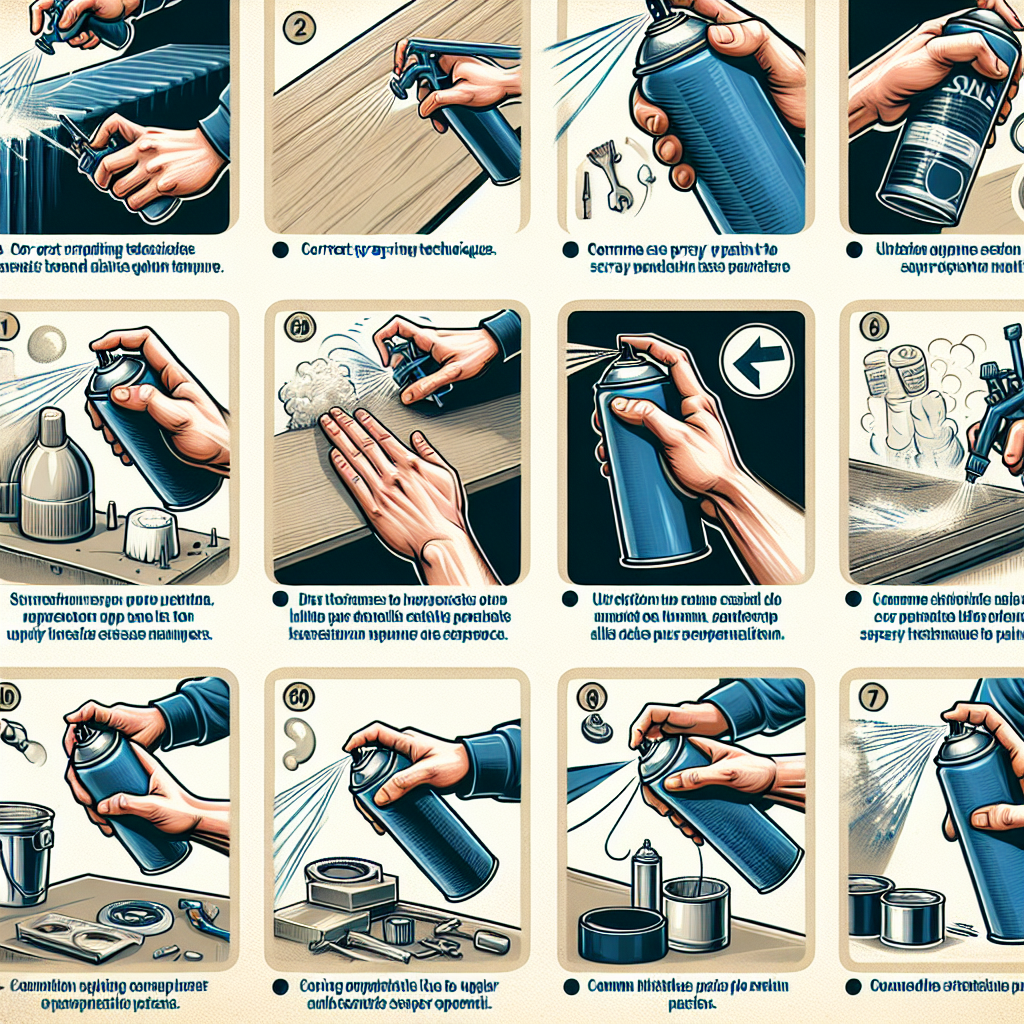In the world of spray painting, achieving a smooth and flawless finish can sometimes be a challenging task. The last thing you want is to end up with unsightly stripes ruining your hard work. Fear not, for this article will provide you with valuable insights on how to avoid those unwanted streaks and achieve a professional-looking spray paint job. By following these expert tips and techniques, you will be able to achieve a smooth, even application that will leave your projects looking flawless and free of any distracting stripes. Say goodbye to uneven finishes and hello to a flawless spray painting experience.
Choose the Right Tools and Equipment
When it comes to achieving a smooth and flawless finish in your spray painting project, choosing the right tools and equipment is essential. One of the most important tools you’ll need is a high-quality spray gun. A reliable spray gun will ensure an even distribution of paint and minimize the risk of creating stripes. Look for a spray gun that is known for its durability and precision.
In addition to a quality spray gun, it’s crucial to ensure that the nozzle size is appropriate for the type of project you are working on. The size of the nozzle determines the width of the spray pattern and the amount of paint being sprayed. Selecting the correct nozzle size will help you achieve the desired coverage without creating stripes or unevenness.
Another critical component of your equipment setup is the compressor. It is important to use a compressor with adequate pressure and air volume. Insufficient pressure can result in a weak and inconsistent spray pattern, leading to the formation of stripes. Make sure to choose a compressor that can deliver the necessary air pressure and volume for your specific painting project.
Prepare the Surface Properly
No matter how high-quality your tools and equipment are, they won’t deliver satisfactory results if the surface you are painting on is not prepared properly. Before starting any spray painting job, ensure that the surface is clean and free from any dirt, debris, or other contaminants. Cleaning the surface thoroughly will prevent any particles from getting trapped in the paint and causing unwanted stripes.
In addition to cleaning, it is important to remove any existing paint or coating that is peeling, flaking, or in poor condition. This can be accomplished through sanding or using paint removers. Strive for a smooth and even substrate to avoid any imperfections that may show through the final paint job. Repair any damages, such as dents or cracks, and fill in any imperfections to create a flawless surface for painting.

This image is property of images.unsplash.com.
Prime the Surface
Applying a suitable primer is an essential step to promote adhesion and ensure the longevity of your spray paint job. The primer acts as a base coat, providing a smooth, consistent, and adhesive surface for the paint to adhere to. Choose a primer specifically designed for the type of material you are painting, whether it’s wood, metal, or plastic. Applying the primer evenly and allowing it to dry completely is crucial for avoiding stripes and achieving a professional finish.
Once the primer has dried, it is important to sand the primed surface for smoothness. Lightly sanding the surface with fine-grit sandpaper will remove any minor imperfections and create an even texture for the paint to adhere to. Sanding also helps ensure a uniform application of the paint, preventing the formation of stripes or uneven patches.
Choose the Right Paint
Choosing the right paint is another crucial factor in avoiding stripes when spray painting. Opt for high-quality spray paint from reputable brands to ensure excellent coverage and a smooth finish. Cheap or low-quality paints may have inconsistent pigmentation or viscosity, leading to uneven application and potential stripe formation.
Consider the viscosity and flow of the paint you choose. Thicker paints may require higher pressures and larger nozzle sizes, while thinner paints may require lower pressures and smaller nozzle sizes. Understanding the paint’s viscosity and flow will help you adjust your equipment settings accordingly, minimizing the risk of creating stripes.
Additionally, when selecting the paint, consider the desired finish. Whether you prefer a glossy, satin, or matte finish, choose a paint that offers the desired sheen level. Different finishes can create different visual effects, so select the one that best suits your project.

This image is property of images.unsplash.com.
Practice Proper Spraying Techniques
Even with the right tools and equipment, proper spraying techniques are crucial to avoid creating stripes in your paint job. Maintaining a consistent spraying distance is important throughout the entire process. Too close or too far away from the surface can result in uneven coverage and streaks. Aim for a distance of around 6 to 8 inches for optimal results.
When applying the paint, use even and overlapping strokes to achieve a smooth and consistent appearance. Start each stroke slightly before the previous one ends to avoid leaving visible lines or edges. It is crucial to maintain a continuous and even motion to prevent streaks and ensure an even layer of paint.
It is also important to avoid spraying in extremely hot or cold conditions. Extreme temperatures can affect the consistency of the paint and cause it to dry too quickly or not adhere properly. Aim to spray paint in a controlled environment with moderate temperatures to achieve the best possible results.
Control the Spray Pattern
Controlling the spray pattern is another key aspect of avoiding stripes in your spray painting project. Adjusting the spray gun’s fan width allows you to tailor the spray pattern to your desired coverage. Understanding how to adjust the fan width will help you achieve an even application of paint without any streaks or lines.
Regulating the paint flow rate is also crucial for controlling the spray pattern. Adjusting the flow rate will determine the amount of paint being sprayed and the level of coverage achieved. Experiment with different flow rates to find the optimal setting for your specific project. Remember to start with a lower flow rate and gradually increase it to avoid applying too much paint at once.
Holding the spray gun at the correct angle is yet another important factor in controlling the spray pattern and avoiding stripes. Generally, it is best to hold the gun perpendicular to the surface being painted, maintaining a consistent distance. Tilting the spray gun at an angle can result in uneven coverage and stripes, so it is important to keep the gun parallel to the surface.

This image is property of images.unsplash.com.
Apply Thin Coats
To achieve a professional finish and minimize the risk of creating stripes, it is important to apply thin coats of paint. Avoid the temptation to apply heavy coats as they can lead to runs, drips, and streaks. Multiple thin coats provide better results, allowing each layer to dry properly and adhere evenly to the surface.
After applying each coat, allow it to dry fully before applying the next. Rushing the drying process can result in paint mixing or smudging, leading to an uneven finish. Patience is key in achieving a flawless paint job without any visible stripes.
Avoid Overlapping Too Much
While overlapping strokes is necessary for even coverage, it’s important to avoid overlapping too much as it can create excessive layering and potential stripes. Overlap each stroke by about 50% to ensure proper coverage without causing visible seams or lines. Maintain a steady and consistent pace throughout the entire painting process to achieve a uniform finish.

Minimize Dust and Debris
To achieve a professional and stripe-free paint job, it is crucial to work in a clean and controlled environment. Dust and debris can easily get caught in the wet paint, causing imperfections and unevenness. Make sure the area where you are painting is clean and free from any loose particles that could contaminate the paint.
Cover nearby objects or surfaces that are not intended to be painted to prevent any accidental contamination. Using drop cloths or plastic covers can help protect the surrounding area from overspray and avoid any unwanted stripes or marks.
In some cases, it may be necessary to use a suitable dust extraction system to minimize dust and debris in the air. This is particularly important when working in environments prone to high levels of dust, such as workshops or construction sites. A dust extraction system can effectively remove airborne particles and ensure a clean painting environment.
Apply a Clear Coat
Consider applying a protective clear coat to further enhance the durability and appearance of your spray paint job. A clear coat acts as a protective layer, guarding against scratches, UV damage, and other environmental factors. It also helps to create a smooth and glossy finish.
Before applying the clear coat, ensure that the paint has fully cured. This is important to prevent any chemical reactions or negative interactions between the paint and clear coat. Follow the manufacturer’s instructions regarding the recommended curing time, as it may vary depending on the specific type of paint used.
When applying the clear coat, ensure an even and consistent application. Overlapping strokes in the same manner as the paint application can help achieve an even distribution. Be mindful of the drying time mentioned in the manufacturer’s instructions to allow the clear coat to cure properly and avoid any potential stripes or imperfections.
By following these steps and guidelines, you can achieve a professional and stripe-free spray paint job. Remember to choose the right tools and equipment, properly prepare the surface, select the appropriate paint and practice proper spraying techniques. Taking the necessary time and care will result in outstanding and flawless finishes on your spray painting projects.




